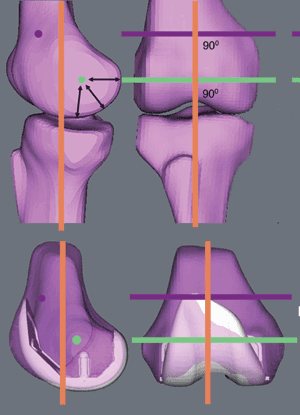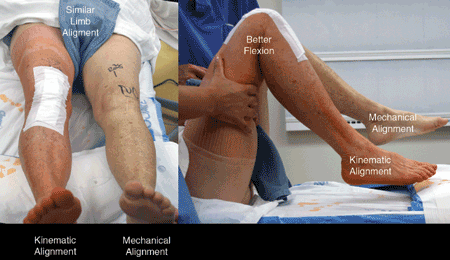Kinematic vs. mechanical alignment: What is the difference?
In this 4 Questions interview, Stephen M. Howell, MD, explains the potential benefits of 3D alignment during total knee replacement.
Introduction
The topic and arguments concerning mechanical vs. kinematic alignment of knee replacements can be confusing the first few times you read about it. This month I asked Stephen M. Howell, MD, to respond succinctly to four related questions. The purpose of these questions is to give further insight to our readers as they listen to future presentations and read new literature published on this topic.
— Douglas W. Jackson, MD
Chief Medical Editor
Douglas W. Jackson, MD: What does the mechanical alignment of a total knee mean?
Stephen M. Howell, MD: Mechanical alignment considers only the two-dimensional (2D) alignment of the limb and knee in the coronal or frontal plane. Devotees of navigational instruments strive to cut the distal femur perpendicular to a line drawn from the center of the femoral head to the center of the knee — the mechanical axis of the femur — and cut the proximal tibia perpendicular to a line drawn from the center of the knee to the center of the ankle — the mechanical axis of the tibia. Most surgeons using conventional instruments place an intramedullary rod in the distal femur set at a fixed angle (usually 5°· or 6°·) to make the distal femoral cut and use an extramedullary guide to make the ‘classic tibial cut’ perpendicular to the mechanical axis of the tibia.
In most patients, mechanically aligning the limb and components to a neutral or 0· hip-knee-ankle angle changes the obliquity and raises the joint line from normal. These changes in the joint line require a compensatory change in the axial rotation of the femoral component to minimize the inevitable imbalance of the collateral and retinacular ligaments. However, placing the femoral component at a different obliquity and level of joint line from normal alters the patellofemoral and tibiofemoral kinematics, which can cause patellofemoral pain, instability, and loss of motion.
 Stephen M. Howell |
These changes in the joint line result from referencing the center of the femoral head and ankle and are caused by the wide variability and unrelated longitudinal shapes of the femur and tibia in a given limb. The variability and unrelated longitudinal shapes of the femur and tibia explains why only 2% of normal limbs have a 0° hip-knee-ankle angle. Changing the obliquity and level of the joint line from normal often requires releases of the collateral and lateral retinacular ligaments and is believed to lead to increased wear and explain the 18% to 25% prevalence of patients not satisfied with their total knee arthroplasty (TKA).
Jackson: How does this differ from kinematic alignment of the knee?
Howell: Kinematic alignment considers the 3D alignment of the components with respect to the knee instead of the 2D alignment of the components with respect to the center of the femoral head and ankle. The intent of kinematic alignment is the restoration of the normal 3D orientation of the three axes that describe normal knee kinematics.
By definition, the three kinematic axes are a transverse axis in the femur about which the tibia flexes and extends, a transverse axis in the femur about which the patella flexes and extends, and a longitudinal axis in the tibia about which that tibia internally and externally rotates on the femur. The parallel and orthogonal relationships between these three axes do not vary between knees.
|
Images: Howell SM |
In TKA, the two parallel transverse axes in the femur about which the tibia and patella flex and extend are re-established by surface or shape-fitting a femoral component with symmetric, single-radius condyles on the articular surface of the femur after correcting for wear.
Intraoperatively, kinematic alignment is performed with patient-specific guides. Kinematic alignment of the femoral component is confirmed when the thickness of the two distal and two posterior bone resections plus the thickness of the wear (typically 1 mm to 2 mm) plus the thickness of the kerf from sawing the bone (typically 1 mm to 1.5 mm) equals the thickness of the femoral component. For a typical varus knee reconstructed with 8 -mm thick distal and posterior femoral condyles on the femoral component, the thickness of the distal medial resection should be 5 mm, the posterior medial resection should be 6 mm, and the distal and posterior lateral resections should be 7 mm. If the femoral component is 10-mm thick then each bone resection should be 2-mm thicker than the cuts for an 8-mm thick femoral component. For a typical valgus knee, the pattern of the bone resections should be reversed with the thinner resections lateral and the thicker resections medial. Rarely is additional removal of bone from the distal femur required to correct a flexion contracture.

Recreation of the knee pre- and
postoperative demonstrating the three kinematic axes. The orange vertical
lines demonstrate the longitudinal axis; the purple horizontal lines represent
the transverse axis about which the patella flexes and extends and the green
horizontal lines represent the transverse axis about which the tibia flexes and
extends.
Jackson: Can the alignments be the same in a given patient?
Howell: Surprisingly, the coronal alignment of the limb — the hip-knee-ankle angle — and the alignment of the knee — the femoral-tibial angle — are the same in kinematically and mechanically aligned TKA. The main difference is in the alignment of the components with respect to the weight-bearing line connecting the centers of the femoral head and ankle. Kinematic alignment restores the obliquity and level of the joint line anatomically so the femoral component is slightly more valgus (1° to 2°) and the tibial component is slightly more varus (1° to 2°) than mechanically aligned components. Mechanically aligning the TKA changes the obliquity and level of joint line from normal requiring a compensatory change in the axial rotation of the femoral component to minimize the inevitable imbalance of the collateral and retinacular ligaments. Assuming that the alignment of the limb and knee are important for the longevity of the prosthesis; kinematic and mechanical alignment methods should have similar rates of wear, loosening, and survival.
|
|
Jackson: What do you see as the potential benefits to the patient from obtaining the desired kinematic alignment?
Howell: Most surgeons that have performed kinematically aligned TKA have noticed an overall better clinical outcome, better motion, better patient satisfaction, and a quicker recovery than their patients treated with mechanically aligned TKA.
These clinical impressions are supported by an in vivo study of contact mechanics that showed the kinematically aligned prosthesis had a minimal prevalence of adduction (3%) and reverse axial rotation (8.5%), which were less and closer to normal than reports of mechanically aligned TKA.
However, as with any surgical technique, careful attention to detail is required as poor outcomes can occur when the principles of kinematic alignment are not followed. The most helpful intraoperative check is the measurement of the distal and posterior femoral bone resections. Adjusting the thickness of the bone resections to accommodate for the 1 mm to 2 mm of distal and posterior wear on the worn side and kerf confirms the femoral component is kinematically positioned before cementing.
Although the principles of kinematic alignment are time honored since first described by Hollister in 1993, the first clinical use of kinematic alignment in TKA in January 2006 is relatively new. Additional studies are needed to further evaluate the advantages and disadvantages of the use of kinematic alignment in TKA with respect to other alignment methods. We are awaiting a Level 1 randomized, double blind, clinical trial to determine the differences and similarities in alignment, clinical outcome, and motion between kinematically and mechanically aligned TKA.
Editor's Note
This article is different than it appeared in the print version of Orthopedics Today. This online version is the version of record.
Reference:Baker PN, van der Meulen JH, Lewsey J, Gregg PJ. The role of pain and function in determining patient satisfaction after total knee replacement. Data from the National Joint Registry for England and Wales. J Bone Joint Surg (Br). 2007;89(7):893-900.
Coughlin KM, Incavo SJ, Churchill DL, Beynnon BD. Tibial axis and patellar position relative to the femoral epicondylar axis during squatting. J Arthroplasty. 2003;18(8):1048-1055.
Dossett GH. Total Knee Replacement Study Using Standard Cutting Guide vs Otismed MRI Generated Cutting Guide. ClinicalTrials.gov. Phoenix: Department of Veterans Affairs (Phoenix, AZ); 2010.
Eckhoff D, Hogan C, DiMatteo L, Robinson M, Bach J. Difference between the epicondylar and cylindrical axis of the knee. Clin Orthop Relat Res. 2007;461:238-244.
Eckhoff DG, Bach JM, Spitzer VM, et al. Three-dimensional mechanics, kinematics, and morphology of the knee viewed in virtual reality. J Bone Joint Surg (Am). 2005;87 Suppl 2:71-80.
Hollister AM, Jatana S, Singh AK, Sullivan WW, Lupichuk AG. The axes of rotation of the knee. Clin Orthop Relat Res. 1993(290):259-268.
Howell SM, Hodapp EE, Kuznik K, Hull ML. In vivo adduction and reverse axial rotation (external) of the tibial component can be minimized. Orthopedics. 2009;32(5):319.
Howell SM, Howell SJ, Hull ML. Assessment of the radii of the medial and lateral femoral condyles in varus and valgus knees with osteoarthritis. J Bone Joint Surg (Am). 2010;92(1):98-104.
Howell SM, Kuznik K, Hull ML, Siston RA. Longitudinal shapes of the tibia and femur are unrelated and variable. Clin Orthop Relat Res. 2009.
Howell SM, Rogers SL. Method for quantifying patient expectations and early recovery after total knee arthroplasty. Orthopedics. 2009;32(12):884-890.
Noble PC, Conditt MA, Cook KF, Mathis KB. The John Insall Award: Patient expectations affect satisfaction with total knee arthroplasty. Clin Orthop Relat Res. 2006;452:35-43.
Spencer BA, Mont MA, McGrath MS, Boyd B, Mitrick MF. Initial experience with custom-fit total knee replacement: intra-operative events and long-leg coronal alignment. Int Orthop. 2008.
Stephen M. Howell, MD, can be reached at Timberlake Professional Building, 8100 Timberlake Way, Suite F, Sacramento, CA 95823; 916-689-7370; e-mail: sebhowell@mac.com. He is a consultant to Biomet Sports Medicine Inc., an unpaid consultant to OtisMed Inc., receives royalties from Biomet Sports Medicine Inc. and is a stockholder in OtisMed Inc.


